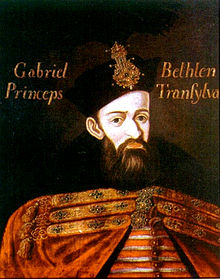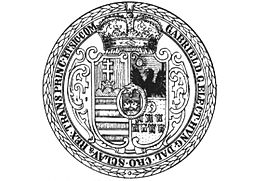| This article needs additional citations for verification. (March 2013) |
| Gabriel Bethlen | |||||
|---|---|---|---|---|---|

Gabriel Bethlen.
|
|||||
| King of Hungary | |||||
| Reign | 25 August 1620 – 31 December 1621 | ||||
| Coronation | Never crowned (anti-king) |
||||
| Predecessor | Matthias II | ||||
| Successor | Ferdinand II | ||||
| Prince of Transylvania | |||||
| Reign | October 1613 – 15 November 1629 | ||||
| Predecessor | Gabriel I | ||||
| Successor | Catherine I | ||||
| Duke of Opole | |||||
| Reign | 1622 – 1625 | ||||
| Predecessor | Sigismund Báthory | ||||
| Successor | Władysław Vasa | ||||
| Spouse | Catherine of Brandenburg | ||||
|
|||||
| Family | Bethlen | ||||
| Born | 1580[1] Marosillye, Principality of Transylvania, (now Ilia, Hunedoara, Romania)[1] |
||||
| Died | 15 November 1629[1] Gyulafehérvár, Principality of Transylvania (now Alba Iulia, Romania)[1] |
||||
| Religion | Calvinism | ||||
Gabriel Bethlen (de Iktár) (Hungarian: Bethlen Gábor, Romanian: Gabriel Bethlen, German: Gabriel Bethlen von Iktár; 1580 - 15 November 1629)[1] was a Protestant King of Hungary[2] (1620-1621), Prince of Transylvania (1613–1629) and Duke of Opole (1622–1625) who led an anti-Habsburg insurrections in Royal Hungary. Bethlen is accused of duplicity in his foreign affairs. [3]
Contents
Biography[edit]
Gabriel Bethlen was a member of the Iktári branch of the Bethlen family of Hungary. He was born at Marosillye (Ilia), Romania and educated at the Lázár Castle, Szárhegy (Lăzarea), Romania, in the care of his uncle, András Lázár. Bethlen was then sent to the court of Sigismund Báthory, a Transylvanian prince and accompanied him to Wallachia.
Bethlen was a Calvinist. He helped György Káldy, a Jesuit, translate and print the Scriptures. He composed hymns and from 1625, employed Johannes Thesselius as kapellmeister.
Prince of Transylvania[edit]
In 1605, Bethlen supported István Bocskay and later, his successor Gabriel Báthory (1608–1613). Bethlen then fell out with Bathory and fled to the Ottoman Empire. In 1613, after the murder of Bathory, the Ottomans installed Bethlen as Prince of Transylvania and this was endorsed on 13 October 1613 by the Transylvanian Diet at Kolozsvár (Cluj-Napoca). In 1615, after the Treaty of Nagyszombat, Bethlen was recognised by Mathias, Holy Roman Emperor. [4]
Bethlen's rule was one of patriarchal enlightened absolutism. He developed mines and industry and nationalised many branches of Transylvania's foreign trade. His agents bought goods at fixed prices and sold them abroad at profit. In his capital, Bethlen built a grand new palace, the Gyulafehérvár (Alba Iulia). Bethlen was a patron of the arts and the Calvinist church, giving hereditary nobility to Protestant priests. Bethlen also encouraged learning by founding the Bethlen Gabor College, encouraging the enrolment of Hungarian academics and teachers and sending Transylvanian students to the Protestant universities of England, the Low Countries, and the Protestant principalities of Germany. He also ensured the right of serf's children to be educated.
Anti-Habsburg insurrection[edit]
Bethlen maintained an efficient standing army of mercenaries. While keeping relations with Ottoman Porte, he sought to gain lands to the north and west. During the Thirty Years' War, he attacked the Habsburgs of Royal Hungary (1619–1626). Bethlen opposed the political absolutism of the Habsburgs; persecution of Protestants in Royal Hungary; the violation of the Peace of Vienna of 1606; and Habsburg alliances with the Ottomans and George Druget, the captain of Upper Hungary.
In August 1619, Bethlen invaded Royal Hungary. In September, he took Kassa (Košice) where Protestant supporters declared him the leader of Hungary and protector of Protestants. He gained control of Upper Hungary (present-day Slovakia). In September 1619, after refusing to reform, the Jesuits, Stefan Pongrac and Melchior Grodeczki were martyred.[5]
In October 1619, Bethlen took Pozsony (Bratislava), where the Palatine ceded the Crown of St Stephen. However, Bethlen, together with Jindrich Matyas Thurn, count of Moravian and Czech estates, did not take Vienna and, in November, the forces of George Druget and Polish mercenaries (lisowczycy) forced Bethlen to leave Austria and Upper Hungary.
Bethlen negotiated for peace at Bratislava, Košice and Besztercebánya (Banská Bystrica). In January 1620, without the Czechs, Bethlen received 13 counties in the east of Royal Hungary. On 20 August 1620, he was elected King of Hungary at the Diet of Besztercebánya and in September 1620, war with the Habsburgs resumed.
After defeating the Czech on 8 November 1620 at the Battle of White Mountain, Ferdinand II persecuted the Protestant nobility of Bohemia. Between May and June 1621, he regained Bratislava and the central mining towns. Bethlen again sued for peace and on 31 December 1621, the Treaty of Nikolsburg was made. Bethlen renounced his royal title on the condition that Hungarian Protestants were given religious freedoms and were included in a general diet within six months. Bethlen was given the title of Imperial Prince (of Hungarian Transylvania), seven counties around the Upper Tisza River and the fortresses of Tokaj, Munkács, and Ecsed, and a duchy in Silesia.
In 1623 - 1624 and 1626, Bethlen, allied with the anti-Habsburg Protestants, made campaigns against Ferdinand in Upper Hungary. The first campaign ended with the Peace of Vienna (1624), the second by the Peace of Pressburg (1626). After the second campaign, Bethlen offered as rapprochement to the court of Vienna an alliance against the Ottomans and his marriage to an archduchess of Austria, but Ferdinand rejected his overtures. On his return from Vienna, Bethlen wed Catherine of Brandenburg, the daughter of John Sigismund, Elector of Brandenburg. His brother-in-law was Gustavus Adolphus of Sweden.
Death[edit]
Bethlen died on 15 November 1629. Catherine became Princess. (His first wife, Zsuzsanna Károlyi, had died in 1622). Bethlen's state correspondence survives as an historical document.
See also[edit]
References[edit]
- ^ a b c d e "Protestáns Honlap" The Protestant webpage. www.lutheran.hu 2003. Accessed 17 December 2009. In Hungarian.
- ^ Sturdy D."Fractured Europe, 1600-1721" Wiley-Blackwell 2002 p45.
- ^ Setton K. "Venice, Austria, and the Turks in the Seventeenth Century." American Philosophical Society, 1991 p34. ISBN 0871691922, 9780871691927
- ^ Varkonyi A. Az Europai jelenlet alternativai, Bethlen Gabor fejedelemme valasztasanak evfordulojara." Magyar Tudomány October 2013. Accessed 15 October 2013. In Hungarian.
- ^ Barti J. "Slovak History: Chronology & Lexicon." Bolchazy-Carducci Publishers, p66, 2002. ISBN 0865164444, 9780865164444.
External links[edit]
 "Bethlen-Gabor". Encyclopedia Americana. 1920.
"Bethlen-Gabor". Encyclopedia Americana. 1920. Chisholm, Hugh, ed. (1911). "Bethlen, Gabriel". Encyclopædia Britannica 3 (11th ed.). Cambridge University Press.
Chisholm, Hugh, ed. (1911). "Bethlen, Gabriel". Encyclopædia Britannica 3 (11th ed.). Cambridge University Press.- History of Slovakia: Part of Historic Hungary II - Modern Times (1526 - 1918).
|
Gabriel Bethlen
|
||
| Regnal titles | ||
|---|---|---|
| Preceded by Gabriel Báthory |
Prince of Transylvania 1613–1629 |
Succeeded by Catherine of Brandenburg |
| Preceded by Ferdinand II |
King of Hungary contested by Ferdinand II 1620–1621 |
Succeeded by Ferdinand II |
| Preceded by Sigismund Báthory |
Duke of Opole 1622–1625 |
Succeeded by Wladislaus IV of Poland |
|












